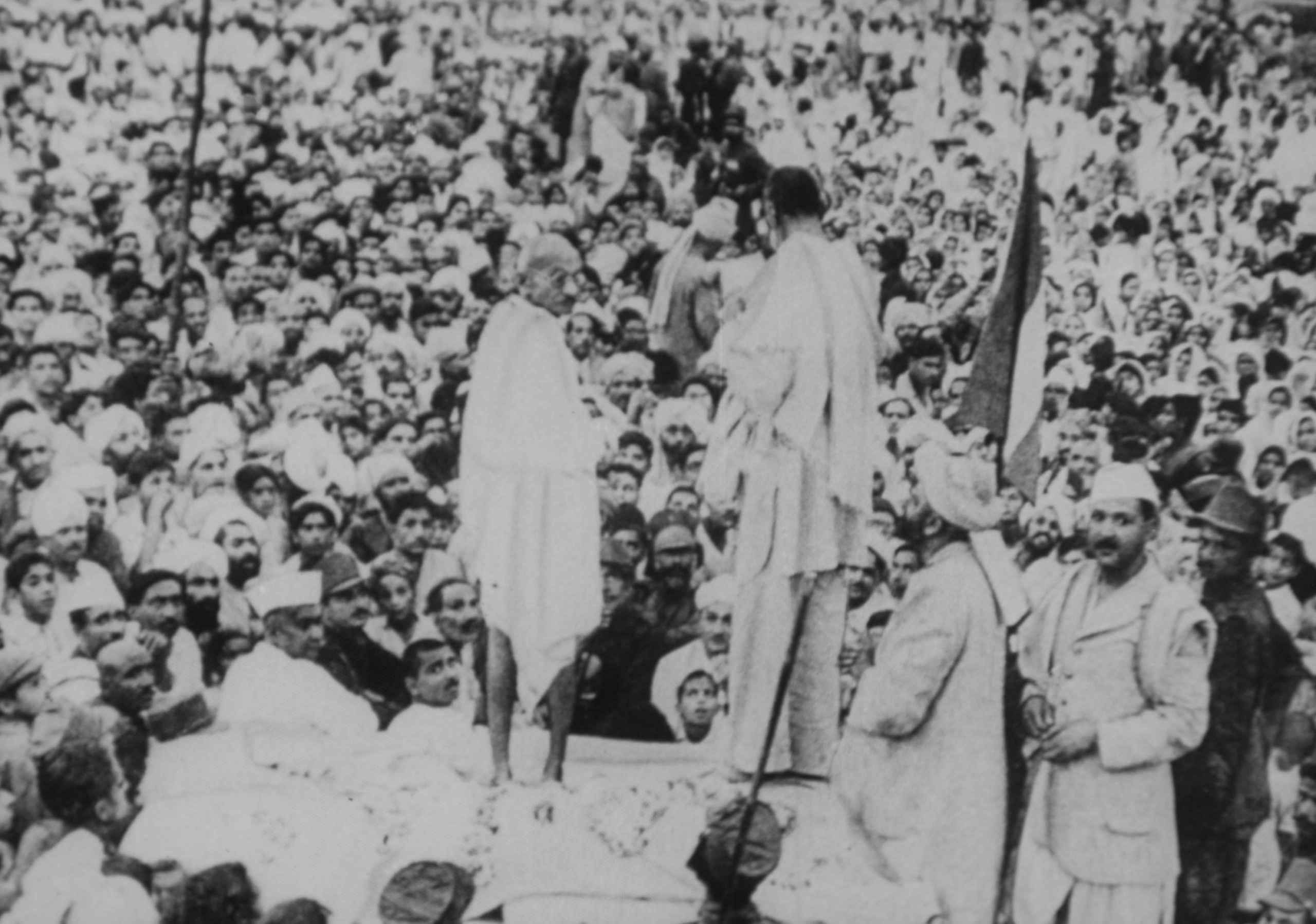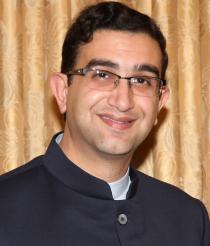
Wikipedia image.
Harvard Worldwide Week, which runs from October 4-8 this year, is an annual showcase of the breadth and depth of Harvard’s global engagement. This year, HWW features numerous events from across the University, including a talk sponsored by the Mittal Institute. Join us on Wednesday, October 6 at 8:00am EST for “India at 75: The Global Roots of Independence,” moderated by Dinyar Patel, Mittal Institute Research Affiliate and Assistant Professor of History at the S.P. Jain Institute of Management and Research (SPJIMR) in Mumbai. He will join a conversation with panelists Nico Slate, Professor and Department Head, Department of History, Carnegie Mellon University and Carolien Stolte, Senior Lecturer in History at Leiden University, The Netherlands.
The Mittal Institute sat down with Dinyar to discuss the event and his new paper, which he will share at the talk.

Dinyar Patel.
Mittal Institute: Dinyar, can you give us a background on your research – what are some of your main foci and interests?
Dinyar Patel: Most of my research is on the early decades of the Indian nationalist movement, roughly the 1860s through the end of World War I. I’m really interested in how Indian political thinkers engaged in very global conversations about rights, freedoms, and, eventually, self-government for India. Indians were remarkably tuned into developments going on around the world: aside from keeping abreast of political change in Great Britain and Western Europe, they paid close attention to the United States from the time of the Civil War onward, and increasingly looked at places as far afield as Liberia, Persia, and Japan to study experiments in modern nation-building by non-European peoples. They were keen to make comparisons with other societies in order to falsify colonial notions of India’s supposed inability to be modern and self-governing.
The bulk of the figures I examine are in Bombay and western India, which has received far less scholarly attention than Calcutta and Bengal. A number of them are Parsis, members of a tiny ethnoreligious community (I’m a Parsi myself). Tracking Bombay’s development in the late 19th century is particularly fascinating. Within the span of a few decades, it went from a rough-and-tumble port town, built upon opium and cotton exports, into a harbinger of Indian modernity and, increasingly, India’s preeminent political and economic center.
My first book, published by Harvard University Press in 2020, is on Dadabhai Naoroji (1825-1917), a Bombay Parsi intellectual who became one of the founders of the Indian National Congress, the first Indian to serve in the British House of Commons, and a completely transformative figure when it comes to modern economic and political thought in India. The breadth of his correspondence is stunning: he was talking to people in the United States, Ireland, South America, Japan, China, South Africa, the Mediterranean world, and Persia.
Mittal Institute: Congratulations on your new paper. What did you explore, and what are some key takeaways from your study?
Dinyar Patel: The paper has been published as “One Man Lobby? Propaganda, Nationalism in the Diaspora, and the India League of America During the Second World War,” Journal of Imperial and Commonwealth History.
This was quite a different research topic for me because, instead of having my head buried in the late 19th and early 20th centuries, I was looking at events in the 1940s: from the beginning of the Second World War through Indian independence. It began with some research at the Library of Congress on Mahatma Gandhi: there, in the papers of John Haynes Holmes, a Universalist minister in New York who was a deep admirer of Gandhi’s philosophy, I came across letters from other Indians in New York, especially a man called J.J. Singh who seemed to be at the center of everything. I followed up these leads at the New York Public Library and the Nehru Memorial Library in New Delhi. What I eventually put together is the story of how a group of nationalist-minded Indians living in New York—with very few resources at their disposal—took on the might of the British government’s propaganda machinery during the Second World War. Incredibly, these expatriate Indians caused some major diplomatic embarrassments to the British.
British authorities in London, New Delhi, New York, and Washington, D.C conducted a propaganda offensive to try to convince Americans that India should not get independence during the war, and that Britain’s policy of imprisoning the Congress leadership (Gandhi, Nehru, and others) was perfectly justified. The India League of America, which those New York Indians had established a few years beforehand, responded by taking British propaganda head-on. They teamed up with American labor activists, African Americans, progressive journalists and writers, and academics to make the case that an independent India would be an asset to the Allies—and that keeping India in colonial chains would simply cost Allied lives and resources. They harnessed American publicity tactics to make their case: in my research, I came across badges and instructions on how to make a “Gandhi hat” which were distributed to American schoolchildren. Most remarkably, people like J.J. Singh became skilled lobbyists in Washington. Singh spent months on Capitol Hill meeting with Democrats and Republicans and cultivating support for Indian independence. The effects were long lasting: friends of the India League, like Rep. Emmanuel Celler (D-NY), championed Indian interests after independence.
Of course, the India League met with stiff resistance from the British. British authorities used tactics of intimidation, tried to get the FBI and Department of Justice to investigate J.J. Singh, and attempted to infiltrate the organization. But the India League, in some senses, got the last laugh: they infiltrated the British Embassy in Washington and most likely helped orchestrate some deeply damaging leaks which ultimately increased American support for Indian independence.
Mittal Institute: Many of your academic articles and newspaper pieces delve into the life and times of revolutionary people – including those who have contributed in great or small ways towards the nationalist movement in India. Can you share some details about who, in your mind, had a profound impact on India’s path toward independence?
Dinyar Patel: There are too many to note! Most of my scholarship has tried to point out that the early nationalists, the generation before Gandhi and Nehru, had a profound impact on the way the nationalist movement, and modern India in general, developed. Their achievements and activities have been quite unfairly downplayed or dismissed in the extant academic scholarship. But this generation had someone like Mahadev Govind Ranade, who developed deeply nuanced ideas on how free trade, that mantra of the British Empire, was profoundly unfair for a colonized society like India and how India therefore needed robust economic protection. Or take Gopal Krishna Gokhale: he literally worked himself to death, pushing for political reform while also recognizing the crying need for access to education, which the British government thoroughly neglected. Then there was Allan Octavian Hume, a Scotsman and a British civil servant who eventually founded the Congress and declared himself to be a “native” of India. All of these people appear in the book I’m currently working on, which delves into the nationalist movement before Gandhi’s time.
While researching for my book on Dadabhai Naoroji, I came across numerous Indians—political leaders and ordinary people—who in their own way made remarkable contributions towards anti-colonialism and aspects of India’s economic and political development. I think it is important to highlight the diversity of these characters. The standard Indian textbook history of the nationalist movement just focuses on a few people, depending how the political winds are blowing.
While researching for my book on Dadabhai Naoroji, I came across numerous Indians—political leaders and ordinary people—who in their own way made remarkable contributions towards anti-colonialism and aspects of India’s economic and political development. I think it is important to highlight the diversity of these characters. The standard Indian textbook history of the nationalist movement just focuses on a few people, depending how the political winds are blowing.
Mittal Institute: Can you preview the October 6 talk for us – what are some major themes you hope to touch upon as moderator?
Dinyar Patel: Both Carolien and Nico are scholars who have thought globally about Indian anti-imperialism. I really admire the work they have done: looking at connections with African and Asian anti-imperialists as well as African Americans. One thing which I think all three of us will be able to highlight is how international travel or residence really shaped the type of political ideas which informed Indian nationalism. For J.J. Singh, over three decades in Manhattan gave him a unique perspective on the workings of democracy and the nuances of US-India diplomacy. Nico will be looking at Kamaladevi Chattopadhyay, an extraordinary female leader who experienced Jim Crow prejudice firsthand while traveling through the South. Carolien will be speaking about Raja Mahendra Pratap, a revolutionary exile who dreamed up a pan-Asian federation in which India would take part.
All three of our stories show how Indian nationalists built up common causes with other people and political movements around the world. I think that this is the really fascinating part about Indian nationalism: nationalists themselves recognized that their struggle was not just about India’s own independence. Their anti-colonial ambitions were quite global in character.
Mittal Institute: As a Research Affiliate since 2020, how has your work benefited from your association with the Mittal Institute?
Dinyar Patel: It is no exaggeration that affiliation with the Mittal Institute has been a lifesaver for me, research-wise. Since I am now based in Mumbai, access to a good research library is already very difficult, and it has been impossible during the pandemic. Affiliation with the Mittal Institute has allowed me access to Harvard Library resources and inter-library loan services. When I was a Ph.D candidate at Harvard, I was in awe of Harvard Library’s resources and capabilities, and I continue to be in awe now. They have helped me source material from around the world for articles and book projects which I’m currently researching and writing.
As importantly, as a Research Affiliate I’ve developed my relations with Harvard faculty members and also met a number of Harvard Ph.D candidates. It has been exciting to learn about their research.
